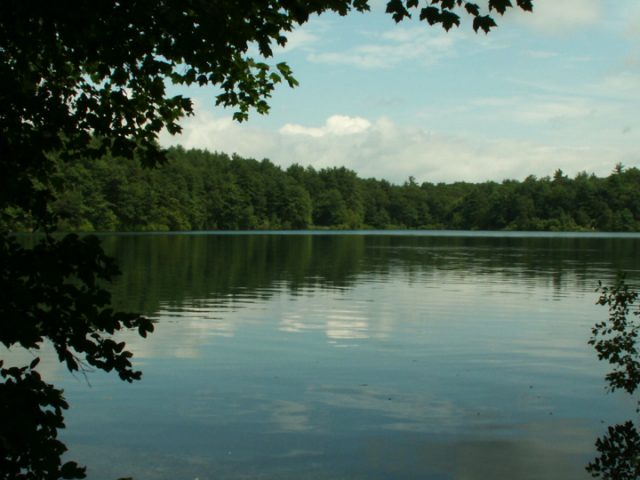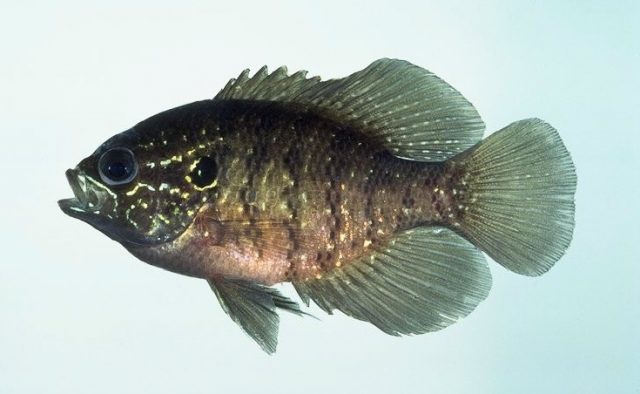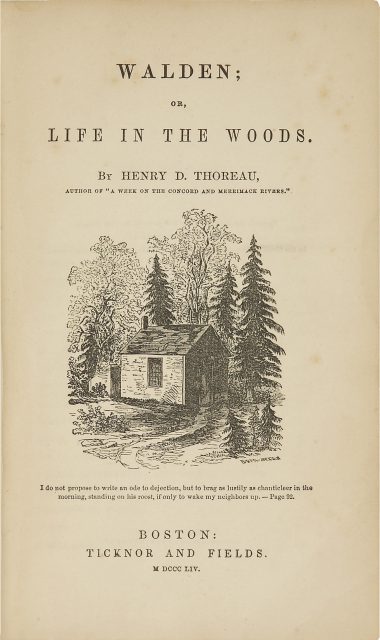The best of both worlds: Henry D. Thoreau on science communication
Author: Antonio Casado da Rocha is Research Fellow, IAS-Research Center for Life, Mind and Society;
Faculty of Education, Philosophy and Anthropology, UPV/EHU.

November 25, 1858, was a very cold day in Concord, Massachusetts. It was then that Henry David Thoreau discovered at Walden Pond some frozen fish he had never seen before, which were “shaped like bream, but had the transverse bars of perch”, as he wrote the following day. “Are they not a new species?” he wondered, and presented them at the next meeting of the Boston Society of Natural History. Opinion was divided, but eventually the specimens were identified as the previously described Enneacanthus obesus. No matter what the final adjudication was, on November 30 Thoreau extensively wrote in his journal about this little scientific adventure. Even though a few days had passed, his exhilaration about the discovery is remarkable:
“I cannot but see still in my mind’s eye those little striped breams poised in Walden’s glaucous water. They balance all the rest of the world in my estimation at present, for this is the bream that I have just found […] It is not like a new bird, a transient visitor that may not be seen again for years, but there it dwells and has dwelt permanently, who can tell how long?”

Thoreau had not seen this fish before, but after having seen it he is taken by wonder and a feeling of almost religious awe. Thoreau knows that the bream is radically different from him, and yet he tries to understand it as a neighbor or contemporary, in its own terms, “to think like a bream for a moment”. To do that kind of job he needs more than the science of his time: he needs “music, poetry, beauty,” the arts, so that for a moment, his anthropocentric system is destabilized and the bream becomes the center of the universe.
“The bream, appreciated,” is much more than simply the bream in a bottle or in a classification. For Thoreau, understanding “the mystery of the bream” is equal to understanding himself or humanity, and thus it makes his own life “more rich and eventful”. And then he compares this feeling with the conventional response of science to a new species: “A new species of fish signifies hardly more than a new name. See what is contributed in the scientific reports. One counts the fin-rays, another measures the intestines, a third daguerreotypes a scale, etc., etc.; otherwise there’s nothing to be said.” In contrast, Thoreau asks himself about the meaning of the discovery:
“It is not that I have got one [bream] in a bottle, that it has got a name in a book, but that I have a little fishy friend in the pond. How was it when the youth first discovered fishes? Was it the number of their fin-rays or their arrangement, or the place of the fish in some system that made the boy dream of them? Is it these things that interest mankind in the fish, the inhabitant of the water? No, but a faint recognition of a living contemporary, a provoking mystery. One boy thinks of fishes and goes a-fishing from the same motive that his brother searches the poets for rare lines. “ (November 30, 1858)
In this passage Thoreau is linking science and the arts in order to get the best of both worlds. The analogy goes a long way, because ultimately what Thoreau is after is “the poetry of fishes”, not simply their flesh, which according to him is their lowest use. The means of life, knowledge itself, need to be connected with the meanings or goals of human life, which is the creation of a life in relation to other humans, fishes, birds, plants, ponds, rivers, mountains, houses, books, tools, and all the natural and cultural phenomena that make up our common world. According to Thoreau, positive emotions such as delight or joy are not only necessary to arrive at scientific truths, but to communicate them.

This year the world celebrates the bicentennial of Henry David Thoreau’s birth in Concord, Massachusetts, in 1817. He is now famous because of his book Walden, in which he described his experience of more than two years living in a little house by that lake, and his essay “Civil Disobedience”, in which that expression was used for the first time. But during his lifetime he was mostly known as a naturalist. In the “Spring” chapter in Walden, Thoreau wrote much about the resilience of nature, its ability for recovery, adjustment and endurance, “the everlasting vigor and fertility of the world” as he put it.
Here I will focus more on social resilience, arguing that the over-specialization and fragmentation of knowledge reinforces vulnerability. My hypothesis is that the resilience of universities is related to the ideal of consilience, or the unity of knowledge. I will try to show how Thoreau is representative of such a drive towards consilience, elaborating this point in reference to his attitude towards science and technology, two of the most important factors shaping our world today.
In Thoreau’s time, science was beginning to claim the place it enjoys today as the most reliable source of knowledge. It was beginning to get professionalized, institutionalized in universities, and increasingly separated from the arts and the literary humanities. In his journal, written between 1837 and 1861, Thoreau reflected about this process, discussing whether a scientific account of the world could really make justice to the plurality of human experience.
It was a crucial time because before that date, science was still an element of the common collective culture in the USA, and there was no central authority or professional science centre giving their credentials to those who would later work in science, often outside the universities. Thoreau was educated in Harvard and worked with scholars such as Louis Agassiz, but the word “scientist” was not of common use in Thoreau’s lifetime (Walls 1995). However, during the 1850s “men of science” began to be identified as a distinct group, educated in universities, and in those years Thoreau observed how the “two cultures”, that of letters and that of the sciences, began to separate. It was not a comfortable situation, and in his journal Thoreau regretted that it was no longer possible “for the same person to see things from the poet’s point of view and that of the man of science.” (February 18, 1852)

Thoreau’s opposition to the split of the two cultures can be seen in his writings about the perception and appreciation of natural elements such as rainbows, clouds, or the landscape. Against the rising tide of positivism, Thoreau described landscape as something not purely natural or cultural, objective or subjective, but as a relationship between subject and object, as a process that is not independent of the observer but rather interacts with him or her. For an example, let us see what Thoreau wrote in his journal on November 5, 1857:
“I think that the man of science makes this mistake, and the mass of mankind along with him: that you should coolly give your chief attention to the phenomenon which excites you as something independent on you, and not as it is related to you. The important fact is its effect on me. He thinks that I have no business to see anything else but just what he defines the rainbow to be, but I care not whether my vision of truth is a waking thought or dream remembered, whether it is seen in the light or in the dark. It is the subject of the vision, the truth alone, that concerns me. The philosopher for whom rainbows, etc., can be explained away never saw them. With regard to such objects, I find that it is not they themselves (with which the men of science deal) that concern me; the point of interest is somewhere between me and them (i. e. the objects).”
The lesson from this passage, whose main idea appears again and again in Thoreau’s writings, is that it is a mistake to think that scientific facts are something neutral, something separate from the scientist and his or her values. The important thing for Thoreau is not the natural object as something independent from his life, but in relation to it.
Thoreau wants to keep the best of both worlds: an actual world open or accessible to science but also a human world, one that is still enchanted and ever mysterious. The world has limits but, according to Thoreau, they are not rigid, they are not fixed forever. By means of human activity and conscious endeavor, he writes, “The limits of the actual are set some thoughts further off.” Thus the universe becomes “wider than our views of it” (Walden), thanks to “the elasticity of our imaginations” (Journal, May 31, 1853).
For Thoreau, the world is never finished; it keeps getting bigger and richer. This exuberance of the world is secured by linguistic means. According to Laura D. Walls (1995: 7), Thoreau saw science primarily as a language, and it is for this reason that he became so interested in it first. Science gave Thoreau new expressive possibilities, making visible modes of reality that otherwise went unseen. This feature is most explicit in his love of scientific names:
“How hard one must work in order to acquire his language,–words by which to express himself! I have known a particular rush, for instance, for at least twenty years, but have ever been prevented from describing some [of] its peculiarities, because I did not know its name nor any one in the neighborhood who could tell me it. With the knowledge of the name comes a distincter recognition and knowledge of the thing. That shore is now more describable, and poetic even. My knowledge was cramped and confined before, and grew rusty because not used,–for it could not be used. My knowledge now becomes communicable and grows by communication. I can now learn what others know about the same thing.” (Journal,August 29, 1858)
There are two interesting things in this passage. First, the recognition that the task of scientific communication is not easy: it takes hard work. Second, in this passage Thoreau compares or even equates the acquisition of knowledge with the acquisition of a language. Of course, communication is essential to science because it helps the diffusion and revision of knowledge. Science moves forward by communication. However, according to Walls (1995: 7), Thoreau sometimes experimented with a more radical formulation: literature and science were not different languages, but in their purest and highest form they were inseparable, they both were “simply some human experience” (May 5, 1854). As personal experience, the best of both worlds –the best science and the best poetry– would come together and would “read” the same.
However, this unifying experience of consilience is indeed very rare. Thoreau complained in his journal about the state of science in 1858. Science was led by Harvard professors who were mainly interested in what we call today “data mining”, getting the facts out of nature without a personal relation to the objects they study:
“We read the English poets; we study botany and zoology and geology, lean and dry as they are; and it is rare that we get a new suggestion. […] We would fain know something more about these animals and stones and trees around us. We are ready to skin the animals alive to come at them. Our scientific names convey a very partial information only; they suggest certain thoughts only.” (March 5, 1858)
Thoreau complains that the activities of reading English literature and studying biology do not fertilize each other. He was beginning to see the split between science and the arts getting bigger, becoming a culture war in which consilience was no longer possible. That pessimism about the current state of science appears in other places in the Journal. Thoreau is concerned about the effects that an impersonal and partial approach to knowledge might cause in the natural world and their inhabitants: “Science is inhuman. Things seen with a microscope begin to be insignificant. […] With our prying instruments we disturb the balance and harmony of nature” (May 1, 1859). “The inhumanity of science concerns me, as when I am tempted to kill a rare snake that I may ascertain its species. I feel that this is not the means of acquiring true knowledge” (May 28, 1854).
Thoreau was concerned about the exponential growth experimented by American science and technology during the 19th century. The ensuing mechanization and rationalization made Thoreau see science as sometimes inhuman (very much as Max Weber would later describe the “disenchantment of the world”). But he also knew, by faith and experience, that science could be humanized and the world re-enchanted. How? By means of some sort of intercultural communication. Just after the 1858 passage quoted above, Thoreau compares his knowledge with that of the Indians he was meeting in his trips to Maine, who were teaching him new names in addition to the scientific ones Thoreau had learnt in his books:
“It does not occur to me that there are other names for most of these [natural] objects, given by a people who stood between me and them, who had better senses than our race. […] No science does more than arrange what knowledge we have of any class of objects. But, generally speaking, how much more conversant was the Indian with any wild animal or plant than we are, and in his language is implied all that intimacy, as much as ours is expressed in our language. […] It was a new light when my guide gave me Indian names for things for which I had only scientific ones before. In proportion as I understood the language, I saw them from a new point of view.” (March 5, 1858)
Thoreau discussed in his journal how language and communication help avoid the risk of making science too rigid and inhuman. Science is humanized by communicating it. But that is not an easy task, since it requires something similar to learning a new language. It might be the language of another human culture, or it might be the language or literature and the arts. The key for Thoreau is that, by means of that language-learning process, one should get closer to some human experience, so that one can share the scientist’s experience or feeling of discovery: “A fact stated barely is dry. It must be the vehicle of some humanity in order to interest us. […] It must be warm, moist, incarnated,–have been breathed on at least. A man has not seen a thing who has not felt it.” (February 23,1860)
Thoreau wanted warm, moist, incarnated, living facts. This is not the same to say that there are no facts, or that any “alternative fact”is as good as other. We now live in a post-truth or post-factual world whose politics is framed largely by appeals to emotion, disconnected from the details of policy. Thoreau did not go that way: he wanted the details, too, so that he could humanize the facts, to make better sense of them and arrive to a more encompassing truth, based on personalized facts. This truth was not the result of science alone, but of consilience, the combined effort of both the sciences and the arts.
References
Walls, Laura D. Seeing New Worlds: Henry David Thoreau and Nineteenth-Century Natural Science. Madison, WI: University of Wisconsin Press, 1995.
Walls, Laura D. (ed.). Material Faith. Henry David Thoreau on Science. Boston: Houghton Mifflin, 1999.